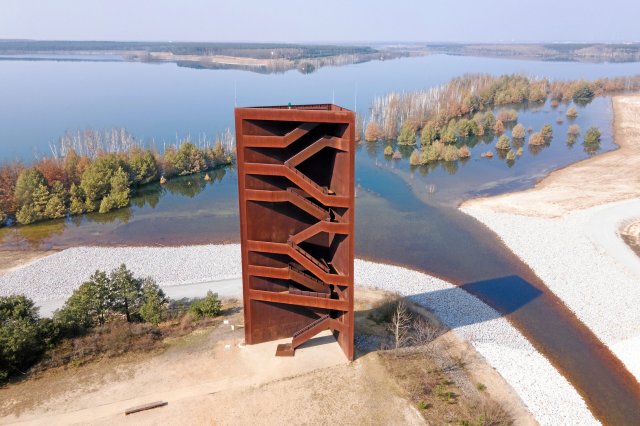Lusatia | Lusatian Lake District: Industrial culture as an adventure playground
It all began with Benedicta Margaretha Baroness von Löwendal. Exactly 300 years ago. Back then, bog iron ore was discovered in Lusatia, and the energetic visionary had a blast furnace built to smelt it. This "hammer in the marsh" went into operation in August 1725. The foundry supplied pots, kettles, stovetops, axles, and wrought iron, providing jobs and, soon, modest prosperity. In the 19th century, the foundry became famous for its structural castings: fountains and bridges, pavilions and portals, candelabras and balustrades, stair railings, and colonnades came from here. The most spectacular object: a 400-ton Moorish-style palace hall for the Viceroy of Egypt.
Since 1839, figures in Lauchhammer were no longer cast exclusively in iron, but also in the much finer bronze. This was primarily for monumental memorials that were shipped as far away as China, Ecuador, and the USA. One of these masterpieces is the enormous Luther Monument in Worms. A model in the Art Casting Museum illustrates the dimensions and sophistication of this craftsmanship. The historic model collection comprises a total of 2,800 pieces. It is a listed monument and can be admired in detail in the museum's display depot.
Lauchhammer's second industrial gem: the Bio Towers, with the lovely nickname "Castel del Monte of Lusatia." Indeed, the ensemble of 24 brick towers certainly resembles the castle of Hohenstaufen Emperor Frederick II in Apulia. They are the last remnants of the massive East German coking plant, which was demolished in 1994. In the towers, strains of bacteria biologically purified the extremely toxic and smelly phenol wastewater from coke production so thoroughly that it was even suitable as fertilizer for agriculture. With their striking aesthetics, the towers are now a fantastic landmark, an attractive event backdrop, and a superb symbol of the transformation in the region.
The Lusatian Lake District has become a region of superlatives. Europe's largest artificial water landscape is growing here. Flooded open-cast mines have been transformed into expansive water worlds; ten lakes will soon be connected by canals and locks. "From Miner to Sailor" is the name given by tour operator Sören Hoika to his excursions, which combine water, change, and culture. Travelers can choose to travel by minibus or bicycle.
In extreme cases, take the 191-kilometer Lakeland Route, where bikers can pedal for four full days, or take a leisurely three-hour lake tour in a van. With tourist beacons like the IBA Terraces in Großräschen, Lake Geierswalde with its floating holiday homes and lighthouse, the Senftenberg city harbor, or the "Rusty Nail," a hypermodern observation tower made of Corten steel, whose rusty patina is also intended to symbolize structural change.
The Knappenrode Energy Factory ingeniously demonstrates how to combine old and new, allowing you to experience 100 years of industrial history with your senses. Behind the brick-red facades of the gigantic former briquette factory, state-of-the-art exhibition worlds of light, metal, and glass are hidden, transforming the visit into an extravagant journey through time. On the "Factory.Experience.Tour," you follow the coal's journey to the finished briquette. An extremely rustic machine with monstrous sieves, dryers, and presses, which – complete with the smell of coal dust and machine oil – still loudly "comes to life" at the touch of a button. "This combination of an originally preserved factory and a state-of-the-art museum concept is truly something special," enthuses director Maria Schöne, "and on top of that, this vast, wonderful, peaceful, and green outdoor area for strolling, enjoying, and lingering – it's truly ingenious."

How the workers of open-cast mines and briquette factories once lived can be seen in another gem of Lusatian industrial culture. In 1917, for example, architect Ewald Kleffel built the Erika Garden City in Laubusch as a housing development for the workers, officials, and directors of the briquette factory, the power plant, and the "Erika" open-cast mine. It featured two-story residential buildings with gardens, a first-class school with a fairytale fountain in the foyer, a cultural center, an inn, commercial buildings, and a church surrounding the central market square. A charming and peaceful colony whose full charm unfolds when you take a stroll with the insiders of the local history society.
Despite all the changes, you shouldn't miss the authentic experience. This is possible at the Welzow-Süd open-cast mine. Here, the black gold is still mined around the clock – up to 20 million tons per year. Anyone who entrusts themselves to the mining tourism association Excursio and meets Bodo Schmidtchen will not only get up close to coal and its colossal mining and conveying machines, they will also be thoroughly entertained. With facts about the sophisticated mining technology and background information on the history of lignite. And all garnished with plenty of mother wit and rustic miner's humor – there won't be a dry eye left.
You can even climb and walk on the most massive of all overburden conveyor bridges at the F60 visitor mine in Lichterfeld. Measuring 502 meters long, 204 meters wide, and weighing over 11,000 tons, the world's largest mobile working machine sits like an overturned Eiffel Tower on the shores of Bergheider Lake, which was "its" open-cast mine until 1992. On guided tours and at heights of up to 78 meters, 65,000 visitors a year climb the giant, which transforms into a light and sound sculpture on weekend nights and regularly serves as a spectacular backdrop for sports and music events, car shows, pyrotechnic displays, and festivals of all kinds.
Incidentally, the colossus was built in nearby Lauchhammer, bringing us full circle again. It's where Lusatia's industrial history began 300 years ago, and where this anniversary is being appropriately celebrated this year.
The research was supported by the Lusatian Lake District Tourism Association.
nd-aktuell




